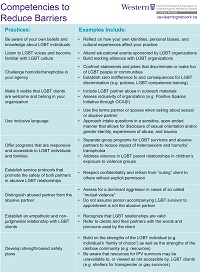Competencies to Reduce Barriers for LGBT Survivors of Intimate Partner Violence
 This infographic lists practices that service providers can incorporate to adress the service berrriers facd by LGBT individuals, it also provides examples of what these practices can entail.
This infographic lists practices that service providers can incorporate to adress the service berrriers facd by LGBT individuals, it also provides examples of what these practices can entail.View Infographic(PDF)
View Infographic(Image)
View Plain Text PDF
Competencies to Reduce Barriers
Practices: |
Examples Include: |
| Be aware of your own beliefs and knowledge about LGBT individuals | Reflect on how your own identities, personal biases, and cultural experiences affect your practice |
| Listen to LGBT voices and become familiar with LGBT culture | Attend educational events sponsored by LGBT organizations Build working alliances with LGBT organizations |
| Challenge homo/bi/transphobia in your agency | Confront statements and jokes that discriminate or make fun of LGBT people or communities Establish zero indifference to and consequences for LGBT discrimination (e.g. policies, LGBT competence training) |
| Make it visible that LGBT clients are welcome and belong in your organization | Include LGBT partner abuse in outreach materials Assess inclusivity of organization (e.g. Positive Spaces Initiative through OCASI) |
| Use inclusive language | Use the terms partner or spouse when asking about sexual or abusive partner Approach intake questions in a sensitive, openended manner that allows for disclosure of sexual orientation and/or gender identity, experiences of abuse, and trauma |
| Offer programs that are responsive and accessible to LGBT individuals and families | Separate group programs for LGBT survivors and abusive partners to reduce impact of heterosexism and homo/bi/transphobia Address violence in LGBT parent relationships in children’s exposure to violence groups |
| Establish service protocols that promote the safety of both partners in abusive LGBT relationships | Respect confidentiality and refrain from “outing” client to others without explicit permission |
| Distinguish abused partner from the abusive partner | Assess for a dominant aggressor in cases of so called “mutual violence” Do not assume person accompanying LGBT survivor to appointment is not the abusive partner |
| Establish an empathetic and nonjudgmental relationship with LGBT clients | Recognize that LGBT relationships are valid Refer to clients and their partners with the words and pronouns used by the client |
| Develop strength-based safety plans | Build on the strengths of the LGBT individual (e.g. individual’s “family of choice”) as well as the strengths of the rainbow community (e.g. resources) Be aware that resources for IPV survivors may be unavailable to, or viewed as not accessible by, LGBT clients (e.g. shelters for transgender or gay survivors) |
This infographic emerged from Issue-Based Newsletter 12: Intimate Partner Violence in Rainbow Communities.
Interested in using Learning Network resources?
All our resources are open-access and can be shared (e.g., linked, downloaded and sent) or cited with credit. If you would like to adapt and/or edit, translate, or embed/upload our content on your website/training materials (e.g., Webinar video), please email us at gbvln@uwo.ca so that we can work together to do so.
All our resources are open-access and can be shared (e.g., linked, downloaded and sent) or cited with credit. If you would like to adapt and/or edit, translate, or embed/upload our content on your website/training materials (e.g., Webinar video), please email us at gbvln@uwo.ca so that we can work together to do so.






